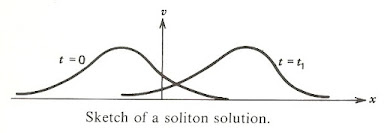In space plasma physics many situations arise in which one will wish to examine the behavior of a solitary wave - say in a particular plasma environment. One such is for nonlinear ion-acoustic waves.
The solitary wave (soliton) is just a traveling wave of form:
u(x, t) = f(x - ct)
for some smooth function f that decays rapidly at infinity and under certain conditions can travel without change of shape (see graphic).
Consider the partial differential equation:
utt - uxx = u ( 2 u2 - 1)
Which has a family of solitary wave solutions:
u(x,t) = sech (x cos q + t sinh q)
We do not expect, for mathematical reasons, the sum of two such solutions (superposition) to also be a solution. There is, however, a class of soliton equations which does exhibit a form of nonlinear superposition. An n-soliton solution then is a solution that is asymptotic to a nontrivial sum of n solitary waves, e.g.
å nt=1 f i (x - ci t) as t -> - oo and to the sum of the same waves:
å nt=1 f i (x - ci t + ri)
with non-zero phase shifts ri as t -> oo. I.e. after nonlinear interaction the individual solitary waves pass through each other, keeping their velocities and shapes - but with phase shifts.
The Korteweg de Vries (KdV) equation:
(- v o + c s + v) ¶ v / ¶x’ - m ¶ 2 v / ¶x2’
+ a ¶ 3 v / ¶x3 = 0
is a well known example of such a soliton equation admitting nonlinear superposition. Here c s is the ion sound speed, and v o the electron thermal speed. In the form shown we note the appearance of the dissipative term (m ¶ 2 v / ¶x2) and that for a soliton to evolve into a shock a dissipative mechanism is needed. In the more common situation steepening of the wave balances dispersion and one will obtain a wave form such a shown in the top graphic. We focus more on this case now by adjusting the KdV equation.
On integrating once, and excluding the shock evolution term (in m) , we obtain:

No comments:
Post a Comment